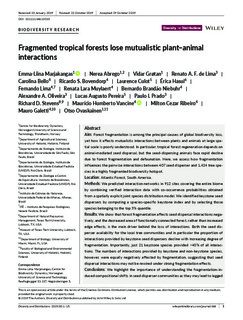| dc.contributor.author | Marjakangas, Emma-Liina | |
| dc.contributor.author | Abrego, Nerea | |
| dc.contributor.author | Grøtan, Vidar | |
| dc.contributor.author | de Lima, Renato A.F. | |
| dc.contributor.author | Bello, Caroline | |
| dc.contributor.author | Bovendorp, Ricardo S | |
| dc.contributor.author | Laurence, Culot | |
| dc.contributor.author | Hasui, Érica | |
| dc.contributor.author | Lima, Fernando | |
| dc.contributor.author | Muylaert, Renata Lara | |
| dc.contributor.author | Niebuhr, Bernardo Brandão | |
| dc.contributor.author | Oliveira, Alexandre A. | |
| dc.contributor.author | Pereira, Lucas Augusto | |
| dc.contributor.author | Prado, Paulo I. | |
| dc.contributor.author | Stevens, Richard D. | |
| dc.contributor.author | Vancine, Maurício Humberto | |
| dc.contributor.author | Ribeiro, Milton Cezar | |
| dc.contributor.author | Galetti, Mauro | |
| dc.contributor.author | Ovaskainen, Otso | |
| dc.date.accessioned | 2020-01-21T09:53:01Z | |
| dc.date.available | 2020-01-21T09:53:01Z | |
| dc.date.created | 2020-01-17T14:11:16Z | |
| dc.date.issued | 2019 | |
| dc.identifier.citation | Diversity and Distributions: A journal of biological invasions and biodiversity. 2019, 00 . | nb_NO |
| dc.identifier.issn | 1366-9516 | |
| dc.identifier.uri | http://hdl.handle.net/11250/2637178 | |
| dc.description.abstract | Aim
Forest fragmentation is among the principal causes of global biodiversity loss, yet how it affects mutualistic interactions between plants and animals at large spatial scale is poorly understood. In particular, tropical forest regeneration depends on animal‐mediated seed dispersal, but the seed‐dispersing animals face rapid decline due to forest fragmentation and defaunation. Here, we assess how fragmentation influences the pairwise interactions between 407 seed disperser and 1,424 tree species in a highly fragmented biodiversity hotspot.
Location
Atlantic Forest, South America.
Methods
We predicted interaction networks in 912 sites covering the entire biome by combining verified interaction data with co‐occurrence probabilities obtained from a spatially explicit joint species distribution model. We identified keystone seed dispersers by computing a species‐specific keystone index and by selecting those species belonging to the top 5% quantile.
Results
We show that forest fragmentation affects seed dispersal interactions negatively, and the decreased area of functionally connected forest, rather than increased edge effects, is the main driver behind the loss of interactions. Both the seed disperser availability for the local tree communities and in particular the proportion of interactions provided by keystone seed dispersers decline with increasing degree of fragmentation. Importantly, just 21 keystone species provided >40% of all interactions. The numbers of interactions provided by keystone and non‐keystone species, however, were equally negatively affected by fragmentation, suggesting that seed dispersal interactions may not be rewired under strong fragmentation effects.
Conclusions
We highlight the importance of understanding the fragmentation‐induced compositional shifts in seed disperser communities as they may lead to lagged and multiplicative effects on tree communities. Our results illustrate the utility of model‐based prediction of interaction networks as well as model‐based identification of keystone species as a tool for prioritizing conservation efforts. Similar modelling approaches could be applied to other threatened ecosystems and interaction types globally. | nb_NO |
| dc.language.iso | eng | nb_NO |
| dc.publisher | Wiley | nb_NO |
| dc.rights | Navngivelse 4.0 Internasjonal | * |
| dc.rights.uri | http://creativecommons.org/licenses/by/4.0/deed.no | * |
| dc.title | Fragmented tropical forests lose mutualistic plant–animal interactions | nb_NO |
| dc.type | Journal article | nb_NO |
| dc.type | Peer reviewed | nb_NO |
| dc.description.version | publishedVersion | nb_NO |
| dc.source.pagenumber | 15 | nb_NO |
| dc.source.volume | 00 | nb_NO |
| dc.source.journal | Diversity and Distributions: A journal of biological invasions and biodiversity | nb_NO |
| dc.identifier.doi | 10.1111/ddi.13010 | |
| dc.identifier.cristin | 1775941 | |
| dc.description.localcode | © 2019 The Authors. This is an open access article under the terms of the Creative Commons Attribution License, which permits use, distribution and reproduction in any medium, provided the original work is properly cited. | nb_NO |
| cristin.unitcode | 194,66,10,0 | |
| cristin.unitcode | 194,63,15,0 | |
| cristin.unitname | Institutt for biologi | |
| cristin.unitname | Institutt for matematiske fag | |
| cristin.ispublished | true | |
| cristin.fulltext | original | |
| cristin.qualitycode | 1 | |

